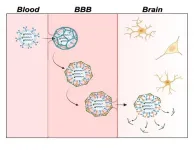(Press-News.org) Heavy rain and flooding in Brazil in November could tell forecasters whether December, January and February in Britain will be cold and dry or mild and wet.
This is because forecasting European winter weather patterns months in advance is made simpler during years of strong El Niño or La Niña events in the tropical Pacific Ocean, a new study has found.
A strong El Nino or La Nina in the Pacific Ocean can bring big changes in temperatures, wind patterns and rainfall patterns to South America. When this occurs, forecasters can more easily tell if Europe will have a mild winter or a cold one. In contrast, when tropical Pacific temperatures were close to average, it was more difficult for forecasters to predict what sort of weather Europe would have in December, January and February.
Dr Laura Baker, lead author of the research at the University of Reading and National Centre for Atmospheric Science, said: “Understanding when seasonal forecasts are likely to be more or less reliable could help everyone from energy companies planning for winter demand to government agencies preparing for potential weather-related emergencies. Our findings could help to improve long-range winter forecasts in other parts of the world, as well as Europe.
“As climate change continues to alter global weather patterns, research like this plays a crucial role in improving our ability to anticipate and prepare for future winter conditions.”
Decades of data
The study, published today (Wed, 31 July) in Geophysical Research Letters, examined the skill of seasonal forecast systems in predicting two key atmospheric patterns that shape winter weather in Europe: the North Atlantic Oscillation (NAO) and East Atlantic Pattern (EA).
The research team analysed 30 years of winter forecasts from seven different prediction systems used across Europe and North America and archived by the ECMWF Copernicus Climate Change Service. By looking at which winters were predicted well or poorly across multiple systems, they were able to identify common factors influencing predictability.
The researchers found that the ability to predict these patterns varies greatly from year to year. Some winters are much more predictable than others, depending on conditions in other parts of the world. The study shows that when strong El Niño or La Niña events are occurring, weather forecasters can place more confidence in long-range predictions for the coming winter. However, in other years, such forecasts should be viewed with more caution.
The study also revealed that unusual conditions in the upper atmosphere over the Arctic can make European winters harder to predict. When sudden changes occur in these high-altitude wind patterns, forecast systems often struggled to anticipate the impacts on weather at ground level.
END
Strong El Nino makes European winters easier to forecast
2024-07-31
ELSE PRESS RELEASES FROM THIS DATE:
MD Anderson and collaborators to launch project studying T cells on International Space Station
2024-07-31
HOUSTON ― The University of Texas MD Anderson Cancer Center and collaborators are initiating a research project that will send T cells to the International Space Station (ISS) to study the effects of prolonged microgravity on cell differentiation, activation, memory and exhaustion. These results will be further analyzed on Earth to uncover signaling pathways and identify potential immune targets that can improve treatment strategies for patients with cancer and other diseases.
To accomplish this work, MD Anderson researchers ...
Chameleon testbed secures $12 million in funding for phase 4: Expanding frontiers in computer science research
2024-07-31
Chameleon, led by Senior Scientist Kate Keahey from Argonne National Laboratory, has been a cornerstone of CS research and education for nearly a decade. The platform has served over 10,000 users, contributing to more than 700 research publications. Chameleon has now secured an additional $12 million in funding from the U.S. National Science Foundation (NSF) to roll out its next four-year phase. With this new funding, Chameleon will continue to innovate and support its growing community, enabling groundbreaking discoveries in CS systems research.
ABOUT CHAMELEON: A PLATFORM FOR INNOVATION
Chameleon is a large-scale, deeply reconfigurable experimental ...
For bigger muscles push close to failure, for strength, maybe not
2024-07-31
When performing resistance training such as lifting weights, there’s a lot of interest in how close you push yourself to failure – the point where you can’t do another rep – and how it affects your results.
While research has looked at this concept in different ways, to date, no meta-analysis has explored the pattern (i.e., linear or non-linear) of how the distance from failure (measured by repetitions in reserve) affects changes in muscle strength and size.
As such, it’s ...
Improving Alzheimer’s disease imaging — with fluorescent sensors
2024-07-31
Neurotransmitter levels in the brain can indicate brain health and neurodegenerative diseases like Alzheimer’s. However, the protective blood-brain barrier (BBB) makes delivering fluorescent sensors that can detect these small molecules to the brain difficult. Now, researchers in ACS Central Science demonstrate a way of packaging these sensors for easy passage across the BBB in mice, allowing for improved brain imaging. With further development, the technology could help advance Alzheimer’s disease diagnosis and treatment.
It is common for neurotransmitter levels ...
Most blood thinner dosing problems happen after initial prescription
2024-07-31
Millions of Americans take anticoagulants, commonly known as blood thinners. These medications work to prevent blood clots that cause heart attack and stroke.
More than two-thirds of those people take a type of blood thinner called a direct oral anticoagulant. DOACs, such as rivaroxaban (brand name Xarelto) and apixaban (brand name Eliquis), are under- or over-prescribed in up to one in eight patents.
These prescribing issues can have life threatening consequences, and they most often occur after a provider writes the initial prescription, according to a study led by Michigan Medicine.
“Direct oral anticoagulants may be viewed ...
AI boosts the power of EEGs, enabling neurologists to quickly, precisely pinpoint signs of dementia
2024-07-31
ROCHESTER, Minn. — Mayo Clinic scientists are using artificial intelligence (AI) and machine learning to analyze electroencephalogram (EEG) tests more quickly and precisely, enabling neurologists to find early signs of dementia among data that typically go unexamined.
The century-old EEG, during which a dozen or more electrodes are stuck to the scalp to monitor brain activity, is often used to detect epilepsy. Its results are interpreted by neurologists and other experts trained to spot patterns among the test's squiggly waves.
In new research published in Brain Communications, scientists at the Mayo Clinic Neurology AI Program (NAIP) demonstrate ...
AI predicts male infertility risk with blood test, no semen needed
2024-07-31
According to a World Health Organization (WHO) study (2017), about half of all infertility is due to men. Semen analysis is considered essential for diagnosis of male infertility, but is not readily available at medical institutions other than those specializing in infertility treatment, and there is a high threshold for receiving it.
In this study, a group led by Associate Professor Hideyuki Kobayashi of the Department of Urology, Toho University School of Medicine, Tokyo, Japan developed an AI model that can predict the risk ...
Researchers pioneer new approach to enhance all-solid-state lithium batteries
2024-07-31
Researchers at the Qingdao Institute of Bioenergy and Bioprocess Technology (QIBEBT) of the Chinese Academy of Sciences, along with collaborators from leading international institutions, have introduced an innovative cathode homogenization strategy for all-solid-state lithium batteries (ASLBs).
This new approach, detailed in their recent publication in Nature Energy on July 31, significantly improves the cycle life and energy density of ASLBs, representing an important advancement in energy storage technology.
Current ASLBs face challenges due to heterogeneous composite cathodes, which require ...
Surprising finding in glioblastomas:
2024-07-31
Glioblastomas are highly aggressive, usually incurable brain tumors. If all therapeutic options are exhausted, patients have an average life expectancy of less than two years. Now researchers from the German Cancer Consortium (DKTK) at the West German Tumor Center Essen have made a surprising discovery: in the vicinity of glioblastomas, they found islands of highly potent immune cells in the neighboring bone marrow of the skull, which play a central role in defending against cancer. The new data may open up prospects ...
Blood proteins may help to track the pathological progression of Lewy’s body disease
2024-07-31
Early detection of Alzheimer’s disease-related changes in Parkinson's disease and dementia with Lewy bodies could be made possible by monitoring the amyloid-β (Aβ) and phosphorylated tau (p-tau) proteins. Researchers at Nagoya University in Japan also discovered the blood levels of neurofilament light chain (NfL) protein is elevated at an early stage of Parkinson's disease (PD) and dementia with Lewy bodies (DLB). This discovery may provide a method to identify potential patients and to make early interventions. The findings were published in npj Parkinson’s Disease.
The two forms of Lewy body disease are PD and DLB. ...





